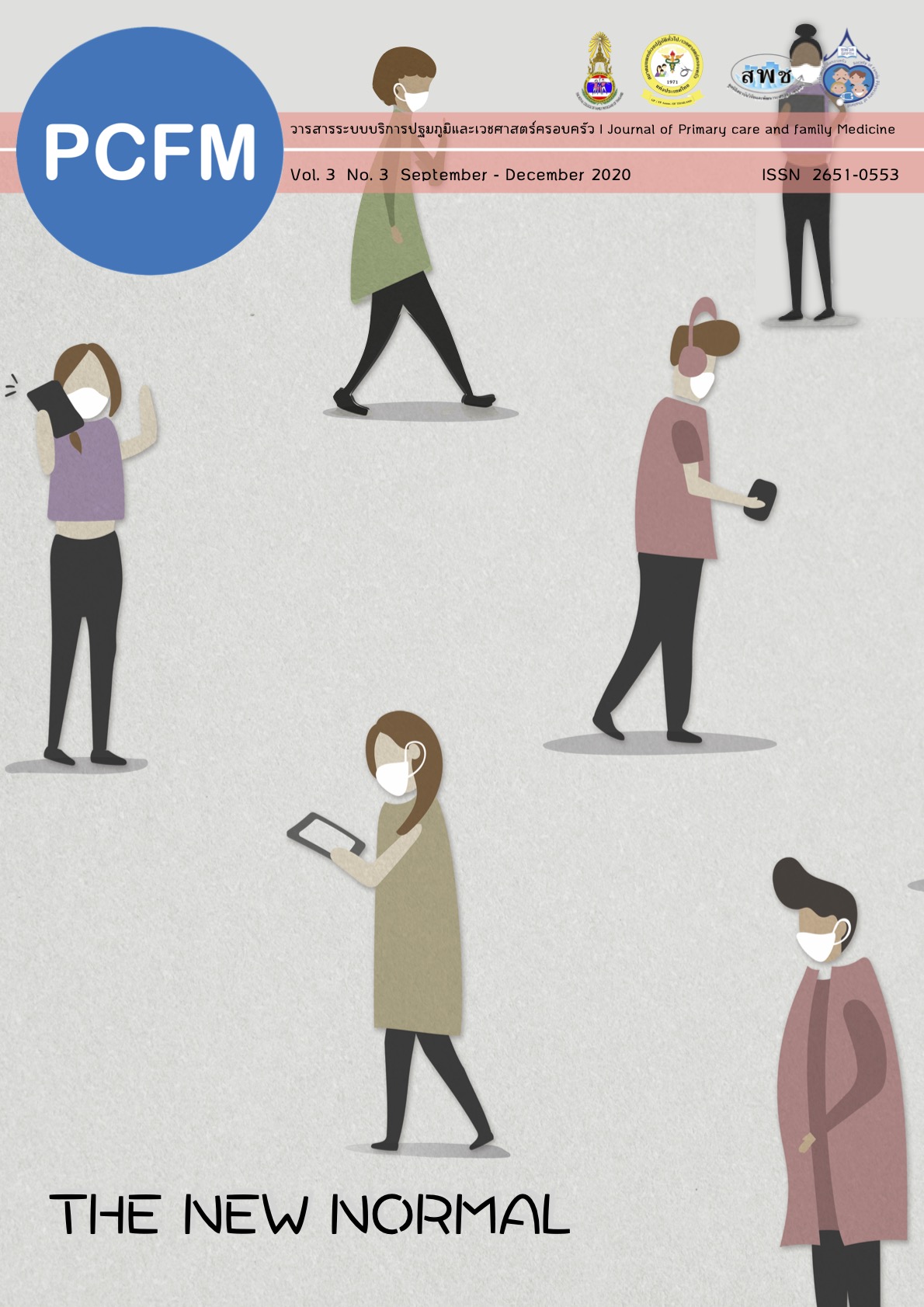สิ่งแวดล้อมในบ้านที่เป็นมิตรสำหรับผู้ที่มีภาวะสมองเสื่อม สิ่งแวดล้อมในบ้านที่เป็นมิตรสำหรับผู้ที่มีภาวะสมองเสื่อม
Main Article Content
บทคัดย่อ
ภาวะสมองเสื่อมเป็นกลุ่มอาการผู้สูงอายุที่มีการเสื่อมลงของปริชาน และความสามารถเชิงปฏิบัติ ส่งผลให้ความสามารถในการทำกิจวัตรประจำวันลดลง ในทางตรงกันข้ามการเกิดปัญหาพฤติกรรมและอารมณ์พบมากขึ้น ดังนั้นการจัดสิ่งแวดล้อมในบ้านให้เป็นมิตรหรือเหมาะสมสำหรับผู้ที่มีภาวะสมองเสื่อมจึงมีความสำคัญ โดยหลักการสิ่งแวดล้อมที่เหมาะสมนอกจากจะเหมือนบ้านของผู้สูงอายุทั่วไป เช่นลดความเสี่ยงที่จะเกิดภาวะหกล้ม แล้วสิ่งแวดล้อมที่เหมาะสมควรเอื้อให้ผู้ป่วยยังคงสามารถในการทำกิจวัตรประจำวันต่างๆได้มากที่สุดเท่าที่จำทำได้ ลดการเกิดอาการทางพฤติกรรมและอารมณ์ กระตุ้นให้มีกิจกรรมปริชาน มีความสะดวกสบาย และให้เกียรติผู้ป่วย ส่งเสริมให้มีกิจกรรม และความสัมพันธ์ต่อกันในครอบครัว และลดความเสี่ยงจากอันตรายที่ไม่คาดคิด ขั้นตอนการประเมินเริ่มจากสอบถามผู้ดูแลเกี่ยวกับสิ่งแวดล้อมภายในบ้าน หลังจากนั้นทีมสหสาขาควรไปเยี่ยมบ้านสำรวจอย่างละเอียดโดยใช้แบบประเมินสิ่งแวดล้อมที่เหมาะสมสำหรับผู้ที่มีภาวะสมองเสื่อม หลังการเยี่ยมบ้านควรให้คำแนะนำเกี่ยวกับการปรับเปลี่ยนสิ่งแวดล้อมในบ้านให้เหมาะสม และมีการติดตามอย่างสม่ำเสมอ
Article Details
เนื้อหาและข้อมูลในบทความที่ลงตีพิมพ์ในวารสาร PCFM ถือเป็นข้อคิดเห็นและความรับผิดชอบของผู้เขียนบทความโดยตรง ซึ่งกองบรรณาธิการวารสารไม่จำเป็นต้องเห็นด้วยหรือร่วมรับผิดชอบใด ๆ
บทความ ข้อมูล เนื้อหา รูปภาพ ฯลฯ ที่ได้รับการตีพิมพ์ลงในวารสาร PCFM ถือเป็นลิขสิทธิ์ของวารสาร PCFM หากบุคคลหรือหน่วยงานใดต้องการนำทั้งหมดหรือส่วนหนึ่งส่วนใดไปเผยแพร่ต่อหรือเพื่อกระทำการใด ๆ จะต้องได้รับอนุญาตเป็นลายลักษณ์อักษรจากวารสาร PCFM ก่อนเท่านั้น
เอกสารอ้างอิง
2. World Health Organization. Dementia: a public health priority [Internet]. 2012. [cite 2020 August 22]. Available from: https://www.who.int/mental_health/publications/dementia_report_2012/en/
3. Thompson GN, Roger K. Understanding the needs of family caregivers of older adults dying with dementia. Palliat Support Care. 2014; 12:223–231.
4. Allan LM, Ballard CG, Rowan EN, Kenny RA. Incidence and prediction of falls in dementia: a prospective study in older people. PloS One 2009;4(5)e5521. doi: 10.1371/journal.pone.0005521.
5. Savva GM, Zaccai J, Matthews FE, Davidson JE, McKeith I, Brayne C. Prevalence, correlates and course of behavioural and psychological symptoms of dementia in the population. Br J Psychiatry 2009; 194: 212–19.
6. De Fazio P, Ciambrone P, Cerminara G, Barbuto E, Bruni A, Gentile P, Talarico A, Lacava R, Gareri P, Segura-García C. Depressive symptoms in caregivers of patients with dementia: demographic variables and burden. Clin Interv Aging. 2015 Jul 1;10:1085-90. doi: 10.2147/CIA.S74439. eCollection 2015.
7. Ganz DA, Latham NK. Prevention of falls in community-dwelling older adults. N Engl J Med 2020;382:734-43.
8. Lim W, Liang C, Asssantachai P, Auyeung TW, Kang L, Lee W, et al. COVID-19 and older people in Asia: Asian Working Group for Sarcopenia calls to actions. Geriatr Gerontol Int 2020;20:547-558.
9. Lin Shih-Yin, Lewis FM. Dementia friendly, dementia capable, and dementia positive: Concepts to prepare for the future. Gerontologist 2015;55(2):237-244.
10. Trahan MA, Kuo J, Carlson MC, Gitlin LN. A systematic review of strategies to foster activity engagement in persons with dementia. Health Educ Behav 2014;41(10):70S-83S.
11. Woodbridge R, Sullivan MP, Harding E, Crustch S, Gilhooly KJ, Gilhooly M, et al. Use of the physical environment to support everyday activities for people with dementia: A systematic review. Dementia (London) 2018;17(5):533-572.
12. Amjad H, Roth DL, Samus QM, Yasar S, Wolff JL. Potentally unsafe activities and living conditions in older adults with dementia. J Am Geriatr Soc 2016;64(6)
13. Lyons RA, John A, Brophy S, Jones SJ, Johansen A, Kemp A, et al. Modification of the home environment for the reduction of injuries. Cochrane Database Syst Rev 2006;(4):CD003600.
14. Marquardt G, Johnston D, Black BS, Morrison A, Rosenblatt A, Lyketsos CG, et al. A descriptive study of home modifications for people with dementia and barriers to implementation. J Hous Elderly 2011;25(3):258-273.
15. Horvath KJ, Trudeau SA, Rudolph JL, Trudeau PA, Duffy MA, Berlowitz D. Clinical trail of a home safety toolkit for Alzheimer' Disease. Int J Alzheimers Dis 2013;2013:913606. doi: 10.1155/2013/913606.
16. Struckmeyer LR, Pickens ND. Home modifications for people with Alzheimer’s Disease: A scoping review. Am J Occup Ther 2016;70(1):7001270020p1-9.
17. Alzheimer’s Association. Alzheimer’s Association Dementia Care Practice Recommendations [Internet]. 2018. [cite 2020 March 22]. Available from: https://www.alz.org/professionals/professional-providers/dementia_care_practice_recommendations
18. Guideline Adaptation Committee, Sydney. Clinical Practice Guidelines and Principles of Care for People with Dementia [Internet]. 2016. [cite 2020 March 22]. Available from: https://www.sydney.edu.au/medicine/cdpc/documents/resources/LAVER_Dementia_Guidleines_recommendations_PRVW5.pdf
19. Calkins MP. Fron research to application: Supportive and therapeutic environments for people living with dementia. Gerontologist 2018;58(suppl1):S114-S128.
20. Bronner K, Perneczky R, McCabe R, Kurz A, Hamann J. Which medical and social decision topics are important after early diagnosis of Alzheimer’s Disease from the persepctives of people with Alzheimer’s Disease, spouses and professionals?. BMC Res Notes 2016;9:149.
21. Callahan CM. Alzheimer’s Disease: Individuals, dyads, communities, and costs. J Am Geriatr Soc 2017;65:892-895.
22. Unwin BK, Andrews CM, Andrews PM, Hanson JL. Therapeutic home adaptations for older adults with disabilities. Am Fam Physician 2009;80(9):963-968.
23. Sanders AE, Nininger J, Absher J, Bennett A, Shugarman S, Roca R. Quality improvement in neurology: Dementia management quality measurement set update. Am J Psychiatry 2017;174(5):493-498.
24. สุกัญญา หังสพฤกษ์, สุดารัตน์ วิจิตรเศรษฐกุล, บรรณาธิการ. คู่มือเยี่ยมบ้านผู้สูงอายุ. ราชวิทยาลัยเวชศาสตร์ครอบครัวแห่งประเทศไทย. นครปฐม: เอส พี กราฟฟิก; 2561.
25. สู่สังคมไม่ทอดทิ้งกันบนเส้นทางสร้างสรรค์สภาพแวดล้อมที่เป็นมิตรกับผู้สูงอายุ. พิมพ์ครั้งที่ 1. กรุงเทพฯ: มูลนิธิสถาบันวิจัยและพัฒนาผู้สูงอายุไทย (มส.ผส.); 2552.
26. Wesson J, Clemson L, Brodaty, Lord S, Taylor M, Gitlin L, Close J. A feasibility study and pilot randomised trial of a tailored prevention program to reduce falls in older people with mild dementia. BMC Geriatric 2013;13:89.
27. Davis R, Weisbeck C. Creating a supportive environment using cues for wayfinding in dementia. J Gerontol Nurs 2016;42(3):36-44.
28. Zucchella C, Sinforiani E, Tamburin S, Federico A, Mantovani E, Bernini S, et al. The multidisciplinary approach to Alzheimer’s Disease and dementia. A narrative review of non-pharmacological treatement. Front Neurol 2018;9:1058.
29. Alzheimer’s Society. Making your home dementia friendly. [Internet]. 2015. [cite 2020 March 22]. Available from: https://dementia.ripfa.org.uk/wp-content/uploads/Alzheimer_s_Society_Dementia_Friendly_Home_booklet_web.pdf
30. Alzheimer’s Association. Dementia Care Practice Recommendations for Professionals Working in a Home Setting [Internet]. 2009. [cite 2020 March 22]. Available from: https://www.alz.org/national/documents/phase_4_home_care_recs.pdf


